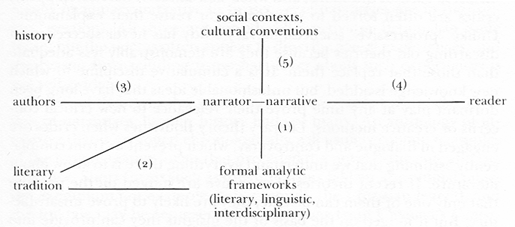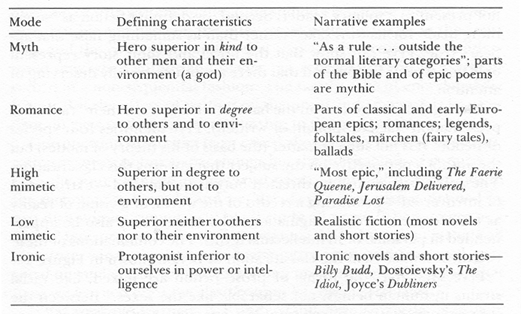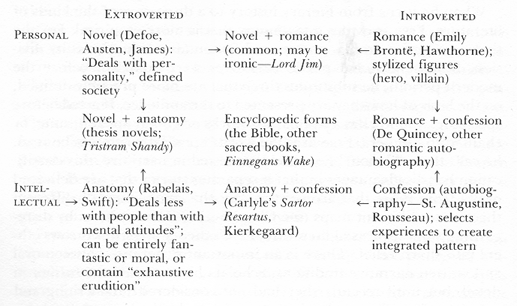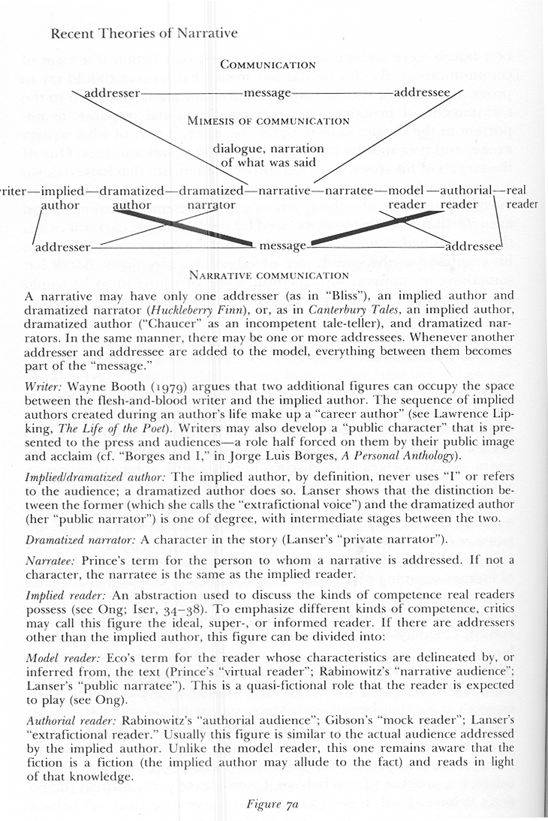Wallace Martin: Recent Theories of Narrative
This book does not seem to describe or endorse a particular theory of narrative on its own, but it does give a historical account of narrative developments and theory, focusing on modern theories especially. In this case modern generally means post 1960, after the emergence of the poststructuralist movement. It may be useful using this to understand the historical influences that shape the perception of narratives and novels as story worlds.
Introduction
Theory of narrative is tightly coupled with theory of the novel. Before narrative theory was explored in general, the topic of study focused on the novel, which is relatively recent as far as traditional media go. Study of the novel primarily seems to have come from formalism and New Criticism. Martin argues that the shift in study to narrative as a whole, including the complexities and ambiguities that arise from such a change of focus, is indicative of a Kuhn-like paradigm shift.
Theories in general have much to do with historical circumstances as with the subject matter itself. The theory of narrative and the novel has a lot to do with the trends and influences in psychology and philosophy. Early theories of the novel were preoccupied with realism, form, and moral situations. When mass production and mass society arose, the conventional class structure was broken down, and it was believed by many that the novel would die out. This is an interesting prediction in pre-1960 narratology, and it is indicative of other fears of catastrophe spurred by social changes. The novel did not die out, but it did change from its social realist upbringing and took on new forms. Beat generation fiction, “new American Gothic,” and other literary movements took the place of realism instead.
More recent studies (as in the first half of the 20th century) use a structuralist approach, and view novels and narratives as ascribing to some mythic structure. This focus is aimed at novelists who broke from the realist tradition, but could still be viewed as representing the monomyth, albeit in many ways. Northrop Frye and Wayne Booth both form alternate views. Frye broadens fiction beyond the novel, into four categories: novel, romance, confession, and anatomy. These categories could be blended to create some hybrid forms. Booth argues for the study of rhetoric in fiction, arguing that fiction is inherently representative and rhetorical.
Martin includes a diagram that illustrates the elements of narratives and the axes which connect them. Different axes are the critical focus of different theories. Martin argues that the multiplicity and variety of literary theory is its strength. This suggests that the full picture and all axes are important.

Martin's narrative axes
From Novel to Narrative
Frye’s work on fiction aims to classify and form categories. Classifications are problematic because they aim to compartmentalize and judge works based on certain determinants and criteria. Frye’s schema is useful because it removes barriers between poetry and prose. The classic and artificial categoires are drama, poetry, and fiction. These are formal differentiations, having nothing to do with the content of the narrative itself.

Frye's narrative modes

Frye's narrative categories. These represent the four main categories and their hybrids.
The result of this discussion is that the diversity of narrative forms within the space of the novel leaves the holistic conception of the novel in ruins. The diversity challenges the understanding of the novel alone, instead the study changes its focus from the novel to narrative. When conventions and restraints are applied, the novel works to push these boundaries and break through them. Much like technology and art, the novel opposes itself to poetics and defies its constraints. The study of form is therefore at odds with the understanding of the medium’s history. These ideas were studied by Shklovsky as literary defamiliarization, and then picked up by Bakhtin.
From Realism to Convention
The novel itself is generally wrapped up as being realistic, and perceived as potentially real. This term is ambiguous, though. One perspective, from James, is that the novel should be written and read as a history. Believability and realism are tied to the attitudes of readers, which tend to fall under three categories: credulity, credence, and skepticism. Wellek and Becker see realism as a period concept, characterized by typicality, objectivity, and causality. For a narrative to be perceived as realistic, it must contain typical circumstances, be understood objectively (in the sense of authorial distance), and events must be connected causally.
Another element of realism is motivation, which indicates the inner lives of characters. The course of narration plots out what happens to characters as a result of motivation, causality, and the author’s intervention. It is in this case that the realist novel conducts itself much like a simulation. The characters are motivated agents, and the world they inhabit obeys causal rules. The author may intervene, but in a limited manner. As a result, unexpected emergent events may occur. That a novel may contain events unexpected to the author is a surprising claim, but is consistent with the view of narrative as simulation. The example given is with Tolstoy’s War and Peace.
Tolstoy decided to create a character who would be killed in a battle. Even if he exists only to die, the character must first be created and endowed with traits that make him interesting; in this case, Tolstoy made him brilliant. “Motivation” requires that such characters be firmly woven into the texture of the novel as a whole, as Tolstoy indicated in a letter: “Since it is awkward to describe a character who in no way is connected with the novel, I decided to make this brilliant, young man the son of old Bolkonsky” (a character important in the chapters that follow the battle). This puppet, born only to die, took on a life of his own. Wars do cause pointless deaths, but they are doubly pointless if they simply illustrate, once again, the horror of war, and the character involved has stimulated but not satisfied our curiosity. “He began to interest me,” Tolstoy wrote; “a role presented itself for him in the further course of the novel, an I had mercy on him, severely wounding him in the place of death.” The character’s survival led to events in the novel that Tolstoy had not originally planned, which themselves required further explanation. This process of motivation, which was well described by Victor Shklovsky and Boris Tomashevsky in the 1920s, is similar to what Frye calls “displacement.” But in Frye’s account of creation, the writer starts from a traditional, archetypal plot (such as is found in myths and romances), and then “displaces” it from its dreamlike unreality to make it plausible from a realistic point of view (134-40) (p. 65)
Narrative necessarily concerns the past. This is necessarily the truth because of the fact that the narrative is written and by the very process of narration. It works in a manner reminiscent to linear games, where local agency falls in the category of narrative compression and omitted inessential details. Histories are narratives and follow biases and trends. Realistic novel is therefore a kind of history.
Narrative Structure: A Comparison of Methods
There is a useful discussion of character here. Character is inseparable from fiction. This is a point that James, Propp, Tomashevsky, and Barthes all would agree on. However, in modern narratives, character and motivation are more important. Instead of characters being substitutable for one another (in the case of Propp), it is the action which may be substituted. Characters remain preserved. This influence makes sense in the sense of variance. In Propp’s account of the folktale, the formal structure is preserved, but characters vary across a bewildering diversity of characters and situations. In modern serial fiction (a great example is sitcom TV shows), characters are constant, but the situations and circumstances vary. The plot of the episodes may remain structurally similar, but the appeal to the audience is the characters reaction to the new situations. This idea is very relevant to the perspective of adaptation as well, as it describes what should be the focal point of the adaptation, plot or character.
The discussion of character and plot gives way to subtle hints at the notion of the story world. In the example of Huck Finn, we view the world more clearly through a flat character. Huck is a flat character because he is not complex and does not grow. As a result, the world that we see through his narration is less distorted. Beyond flat and round characters, there are static and kinetic characters. Kinetic characters may weave in and out of the plot because they occupy different spheres, beyond the sphere of the narrative. This indicates that the narrative itself is a limited view of a larger reality. If all characters were present in the narrative, then the story world would be the entire world that the reader observes. However, when characters exit, the story world is revealed to be larger than the view indicated by the narrative itself. The absence of these characters from the narrative is a point where ambiguity and openness may enter.
From Writer to Reader
Another useful diagram, illustrating the spectrum of understanding the dimension between the reader and the writer. This may be seen as a more detailed view of part of the diagram of narrative axes shown earlier.

From the author to the reader. Barthes would be proud.
| Author/Editor | Martin, Wallace |
| Title | Recent Theories of Narrative |
| Type | book |
| Context | |
| Tags | specials, media theory, narrative |
| Lookup | Google Scholar, Google Books, Amazon |

